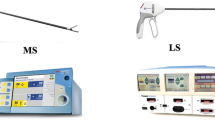Abstract
Purpose
The medical and economic benefits of the transvaginal approach over the abdominal and laparoscopic methods are demonstrated in many studies. Vaginal hysterectomy with bipolar vessel sailing (BiClamp®) represents an example of mininvasive surgery and could be a valid and cost-benefit alternative in the surgical treatment of benign gynaecologic disease. BiClamp® may be carried out according to Clavè’s technique with a good result in postoperative pain.
Methods
Prospective randomized study (Canadian Task Force classification I). We compared the vaginal hysterectomy with salpingo-oophorectomies with BiClamp® and multimodal anaesthesia (group A 30 patients) with vaginal hysterectomy with salpingo-oophorectomies and spinal anaesthesia (group B 30 patients).
Results
The median operating time was 33.5 min for group A and 54.5 min for group B (p < 0.0001). The median blood loss was 59.25 ml in group A and 81.75 ml in group B. The median hospital stay was 1.6 ± 0.58 days for group A and 2.55 ± 0.66 days for group B. Postoperative pain was statistically different between groups in the immediate postoperatory times, at 2 and at 6 h from the surgery and at 10 p.m. (p < 0.0001). Analyses of cost-effectiveness have stated advantages in terms of costs and indirect–direct benefits but also in earlier resumption of working.
Conclusions
BiClamp® technique with multimodal anaesthesia has advantages from surgical, anaesthesiology and economic point of view. It is a minimally invasive surgery characterised by lower morbidity, quicker surgery times and reduced costs when compared to classical vaginal hysterectomy. BiClamp® technique represents a new border in vaginal surgery.
Similar content being viewed by others
References
Kovac SR (2004) Clinical opinion: guidelines for hysterectomy. Am J Obstet Gynecol 191:635–640
Kovac SR (2002) Hysterectomy outcomes in patients with similar indications. Obstet Gynecol 95:787–793
Farquar CM, Steiner CA (2002) Hysterectomy rates in the United States, 1990–1997. Obstet Gynecol 99:229–234
Ottosen C, Lingman G, Ottosen L (2000) Three methods for hysterectomy: a randomised, prospective study of short term outcome. BJOG 107:1380–1385
Cronjè HS, De Coning EC (2005) Electrosurgical bipolar vessel sealing during vaginal hysterectomy. Int J Gynecol Obstet 91:243–245
Levy B, Emery L (2003) Randomized trial of suture versus electrosurgical bipolar vessel sealing in vaginal hysterectomy. Obstet Gynecol 102:147–151
Zubke W, Becker S, Kramer B, Wallwiener D (2004) Vaginal hysterectomy: a new approach using bicoagulatioon forceps. Gynecol Surg 1:179–182
Clavè H, Niccolai P (2003) Hysterectomy sans douleurs: une technique innovante. J Gynecol Obstet Reprod 32:375–380
ERBE Electromédizin GmbH. Waldhörulestraße 17, D72072, Tubingen
Clavè H, Baar H, Niccolai P (2005) Painless vaginal hysterectomy with thermal hemostasis. Gynecol Surg 2(2):101–105
Clavè H, Niccolai P, Zubke W, Becker S (2004) Vaginal Hysterectomy: a new approach using bicoagulation forceps. Gynecol Surg 1:179–182
Zubke W, Hornung R, Wässerer S, Hucke J, Füllers U, Werner C et al (2009) Bipolar coagulation with the BiClamp forceps versus conventional suture ligation: a multicenter randomized controlled trial in 175 vaginal hysterectomy patients. Arch Gynecol Obstet 280(5):753–760
Samulak D, Wilczak M, Michalska MM, Pięta B (2010) Vaginal hysterectomy with bipolar coagulation forceps (BiClamp) as an alternative to the conventional technique. Arch Gynecol Obstet (Epub ahead of print)
Ferraris G (1986) Tecnica chirurgica. Chirurgia Ginecologica e Ostetrica. Utet
Kehlet H (1997) Multimodal approach to control postoperative pathophysiology and rehabilitation. Br J Anaesth 78:606–617
Kehlet H (1999) Acute pain control and accelerated postoperative surgical recovery. Surg Clin North Am 7:431–443
Sculpher M, Manca A, Abbott J et al (2004) Cost effectiveness analysis of laparoscopic hysterectomy compared with standard hysterectomy:result from a randomised trial. BMJ 238:134–137
Crawford BL (2004) Laparoscopic hysterectomy is not cost effective compared with vaginal hysterectomy. Evidence Based Healthc 8:197–199
Conflict of interest
The authors certify that no actual or potential conflict of interest exist in relation to this article.
Author information
Authors and Affiliations
Corresponding author
Rights and permissions
About this article
Cite this article
Leo, L., Riboni, F., Gambaro, C. et al. Vaginal hysterectomy and multimodal anaesthesia with bipolar vessel sailing (Biclamp® forceps) versus conventional suture technique: quality results’ analysis. Arch Gynecol Obstet 285, 1025–1029 (2012). https://doi.org/10.1007/s00404-011-2093-5
Received:
Accepted:
Published:
Issue Date:
DOI: https://doi.org/10.1007/s00404-011-2093-5




